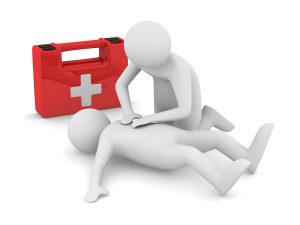 Every year, Emma dresses up as an elf and volunteers for Blist Hill museum. She sees many children hoping to make a good impression with Santa!
Every year, Emma dresses up as an elf and volunteers for Blist Hill museum. She sees many children hoping to make a good impression with Santa!
Christmas brings its own challenges, but how many of those classic health and safety issues we all hear about every year are true? Inspired by and using the Health and Safety Executive (HSE) festive myth busters, which do you think are “festive thumbs up” (true) or Bah Humbug (false)?
Bah Humbug and advice from Gov.uk says
You can clear snow and ice from pavements yourself. It’s unlikely that you’ll be sued or held responsible if someone is injured on a path or pavement if you’ve cleared it carefully.
Bah Humbug and the HSE say:
Each year we hear of companies banning their workers from putting up the Christmas decorations in their offices for ‘health and safety’ reasons, or requiring the work to be done by a ‘qualified’ person. Lets be sensible and provide staff with suitable step ladders to put up decorations rather than expecting staff to balance on wheelie chairs.
Festive thumbs up and advice from HSE says:
Lots of companies waste money in the false belief they need to test their Christmas lights annually, or even don’t put them up at all! By following a few sensible precautions, such as checks by the user for obvious signs of damage, every workplace can switch on safely and sparkle!
Bah Humbug and the HSE say:
Every year we hear inaccurate stories about children who aren’t allowed to throw snowballs, and swimmers who can’t take their traditional winter dip in the local lake – all this in the name of health and safety. We are expected to have snow this Christmas, so lets get out there and have a snowball fight!
Festive thumbs up and what the HSE say:
Finding a coin in your pudding on Christmas day – it’s a tradition that’s lasted for more than 500 years and is said to grant you a good luck wish for the coming year. However, killjoys have been stirring up trouble saying it’s too risky to put coins inside puddings for ‘health and safety’ reasons. Just be careful when taking a bite of pud!
If we had one wish, it would be to stamp out the health and safety Scrooges who try to dampen the Christmas spirit.
Merry Christmas and a Happy New Year to everyone!
 What is seasonal affective disorder?
What is seasonal affective disorder?It is more than the “winter blues” or a general feeling of sadness — it’s a major depressive disorder brought about by the lengthening periods of darkness.
It causes lethargy, low energy, difficulty waking up in the mornings and decreased concentration. It’s an issue that can have drastic effects on productivity in the winter months.
That is dependent on a variety of factors. But, in the UK and Ireland, it is thought to affect as many as one in three people. It’s likely someone you know in the workplace is beginning to struggle with it.
Broadly, SAD has the same outward signs as depression:
•persistent low mood
•loss of pleasure or interest in normal everyday activities
•irritability
•feelings of despair, guilt and worthlessness
•low self-esteem
•feeling stressed or anxious
•reduced sex drive
•becoming less sociable.
There are some SAD-specific signs, though, as follows.
•feeling less active than normal
•lethargy and sleepiness throughout the day
•difficulty concentrating
•an increased appetite, particularly for carbohydrates, which can cause weight gain.
There are some common, easily recognisable risk factors for seasonal affective disorder.
•Women are more likely to suffer from SAD — in fact, they are four times more likely to suffer than men.
•It is more common in everyone the further you get from the equator; the lower hours of sunlight are a big contributor.
•People with a family history of depression are more likely to develop SAD.
•You are more likely to first develop the disorder in younger life. It has even been reported in children.
The most significant and obvious difference between depression and seasonal affective disorder is that SAD is linked to the changing seasons, whereas depression is year-round.
Luckily there are ways to help with SAD that don’t work with “ordinary” depression.
There are some quick and easy ways to make the workplace more manageable for people who suffer from serious winter depression.
•Provide more light: offices can become rather dark and dreary when the sun starts setting earlier. Some employees may be seated at desks or in cubicles situated far from the nearest source of natural light. Try rearranging your floor plan to maximise the natural light available and consider moving people suffering from SAD closer to windows.
•Provide even more light: a lot of people suffering from SAD benefit greatly from a SAD lamp or light box, a form of light therapy that uses fluorescent lights to simulate the natural sun.
•Encourage more outdoor time: employees should be taking lunch away from their desks in all offices — it helps clear the mind and means people are ready to attack the afternoon’s tasks afresh. Encourage your staff to go further than the kitchen. Assuming the winter weather isn’t too harsh, lunchtime can be well spent going for a quick walk around the block. It’s about getting as much sunlight and positivity into the workday as possible. Consider short outdoor meetings and coffee runs.
•Help out with health: SAD can wreak havoc on the appetite, causing weight gain, which can make the associated depression harder to deal with. Provide healthier snacking options and hot drink options, such as diet drinks and soups and herbal teas.
Contact us to discuss this further.
 To prepare for inclement weather, a winter plan should be put together with an associated risk assessment. This should be carried out well in advance, and revisited and revised throughout the cold period.
To prepare for inclement weather, a winter plan should be put together with an associated risk assessment. This should be carried out well in advance, and revisited and revised throughout the cold period.
To make sure everyone understands what is expected of them, and to ensure the plan is as streamlined as possible, it should be completed alongside other areas of the business — for example HR, IT and the communications team. As part of any planning process, include a review of what happened last year so that new approaches can be adopted where processes were less than ideal.
Some areas that could be addressed as part of winter planning are outlined below.
Communication with employees
Staff need to know what is expected of them when bad weather strikes, as well as what they can expect from the organisation. From an HR point of view, it is important for staff to clearly understand what the consequences are of not being able to attend work, for example due to transport disruption or emergency childcare requirements. On the other side of the coin, facilities managers also need to plan for what happens if, for any reason, staff should not come into work, for example if a building loses power or if the heating system goes down.
Communicating with staff is key in these instances, so make sure that the communication plan is clear, approved, and aligned with communication from other departments. Also ensure that managers are on board and understand what is required.
Preventive maintenance
Bad weather and high winds can expose any building flaws, especially in areas such as roofs or windows. Before winter comes, carry out a condition survey to identify any potential problems, and prioritise them for repair.
Similarly, regularly inspect heating systems and any other plant required for emergencies, such as back-up generators. Proactive maintenance and regular inspections will help reduce the chance of failure when these bits of kit are most needed.
Slips and trips
Snow and ice are two obvious winter problems that can be a hindrance to any business. Make sure that supplies of grit are fully stocked, and that weather warnings are regularly checked so that the grit is used when needed. Staff employed to spread grit need proper personal protective equipment (PPE).
Do not forget inside the building too — staff bringing snow and ice in on their shoes can create slippery surfaces, so consider adding extra mats at the front doors to help keep the building clean and to absorb any extra wetness.
Also remember that slips and trips are not just isolated to times when snow falls. Darker mornings and evenings can cause more accidents, as can autumnal leaf fall. As part of maintenance checks, ensure external lighting is adequate and that entrances and pathways are kept clear of leaf litter and debris.
Staff working outdoors
As part of the maintenance team there might be people who are regularly working outdoors. Although minimum working temperatures do not apply for these workers, there is, however, still a duty of care to ensure that people are not working in unsafe conditions. This could mean that managers need to look at rotas to avoid staff working outside in the cold for long periods of time, as well as making sure there are adequate facilities for people to warm up and take a break. Additional PPE to account for the weather can also be appropriate — for example, having extra dry items of clothing and good waterproofs to help people stay warm.
Remote working
Part of the winter preparation might include making sure that people are able to work effectively from home. This might include checking that all staff have the relevant logins and permissions to access work servers remotely. As some staff might not regularly use these systems, ask everyone to check that they can work remotely ahead of time.
Equip fleet vehicles
Make sure fleet vehicles (including grey fleet vehicles) are prepared for winter conditions. This means making a considered decision as to whether winter tyres are necessary, as well as asking staff to undertake some basic checks on weather and road conditions before deciding to drive. It is also a good idea to put together a car “winter pack”, including a blanket, in-car phone charger and snow shovel. Staff can supplement this with personal items that could include warm clothing and food in case they do break down or are stuck on a motorway.
Managing sickness
Along with bad weather comes the dreaded winter flu. Facilities managers can play an important, if not visible, role in reducing the impact of staff illness spreading, for example by stocking up on soap and alcohol gels. It is also a good time to run a check on cleaning schedules to make sure that common areas are being properly, and thoroughly, cleaned to help reduce the spread of germs.
Furthermore, don’t forget that winter doesn’t always mean catching a cold. For some, it can also bring about the onset of Seasonal Affective Disorder (SAD) as well as a propensity for less exercise and a change in diet. Keep this in mind — perhaps renew or re-launch any wellness campaigns, or work with caterers to develop hearty, but healthy, meals for the winter menu.
Contact us if you require further information.
 The Health and Safety (First-Aid) Regulations 1981 require first-aid equipment to be provided as required and state that it should be easily accessible. The minimum requirement is to provide a first-aid box, clearly marked and containing essential first-aid equipment.
The Health and Safety (First-Aid) Regulations 1981 require first-aid equipment to be provided as required and state that it should be easily accessible. The minimum requirement is to provide a first-aid box, clearly marked and containing essential first-aid equipment.There is no defined list of mandatory contents in the regulations. What you include in each box should be determined by your first-aid needs risk assessment.
Reference may be made to the national standard, BS 8599-1:2019 Workplace First-Aid Kits. Most first-aid kits for sale on the market comply with this standard but you are free to include different contents as dictated by your local needs.
Reference might also be made to the example list included in the guidance on the regulations published by the HSE. Appendix 2 of L74 First-Aid at Work states that typical first-aid box contents in a low hazard environment will include:
It is advised that the choice of gloves is made with reference to the risks of allergies caused by some latex gloves. Latex-free or nitrile (synthetic rubber) gloves are available.
Scissors or shears, cleansing wipes and a contents list (for restocking purposes) are also commonly included in first-aid boxes. HSE’s Basic Advice on First-Aid at Work is a good example of a leaflet to include.
L74 recommends that tablets and medicines should not be kept in the first-aid container.
The size, number and placement of your first-aid boxes will also be determined by your first-aid needs assessment. Considerations will include the number of employees, remoteness from emergency medical support, and the category of hazard identified in the workplace environment.
Boxes should be placed around the premises where they will be needed most and where they can be accessed easily.
Any vehicles run by the organisation should have a first-aid travelling kit on board (see L74 for details).
First-aid boxes should be regularly checked and restocked or replaced as necessary. Many items in a first-aid kit will have a limited shelf-life and should be checked to ensure they are still in date.
If you require first aid training, email us for approved suppliers.
If you have any queries, please contact us.
 The safest workplaces are those where health and safety standards are set at a high level – from the very top right down to the very bottom. You have to lead by example and encourage everyone to adopt a safe and compliant attitude across the entire organisation. Ignorance is never a defence if your find yourself in the middle of a RIDDOR investigation.
The safest workplaces are those where health and safety standards are set at a high level – from the very top right down to the very bottom. You have to lead by example and encourage everyone to adopt a safe and compliant attitude across the entire organisation. Ignorance is never a defence if your find yourself in the middle of a RIDDOR investigation.
As a director you have a responsibility to educate yourself about health and safety. You need to know what your role is in ensuring a safe, as well as productive, workplace. Being an executive, getting that title of director, comes with a price – ultimately the buck stops at your desk.
The good news is that, although you need to know the broad outline of health and safety regulations, you don’t need to commit the fine detail to memory. That means you can fit a health and safety course into a single day.
Here are courses that top management could do.
CITB Directors Role for health and safety
IOSH Leading Safety
IOSH Safety for Executives and Directors
If you require advice on booking a course or finding a supplier, please contact us.
We can point you in the right direction.